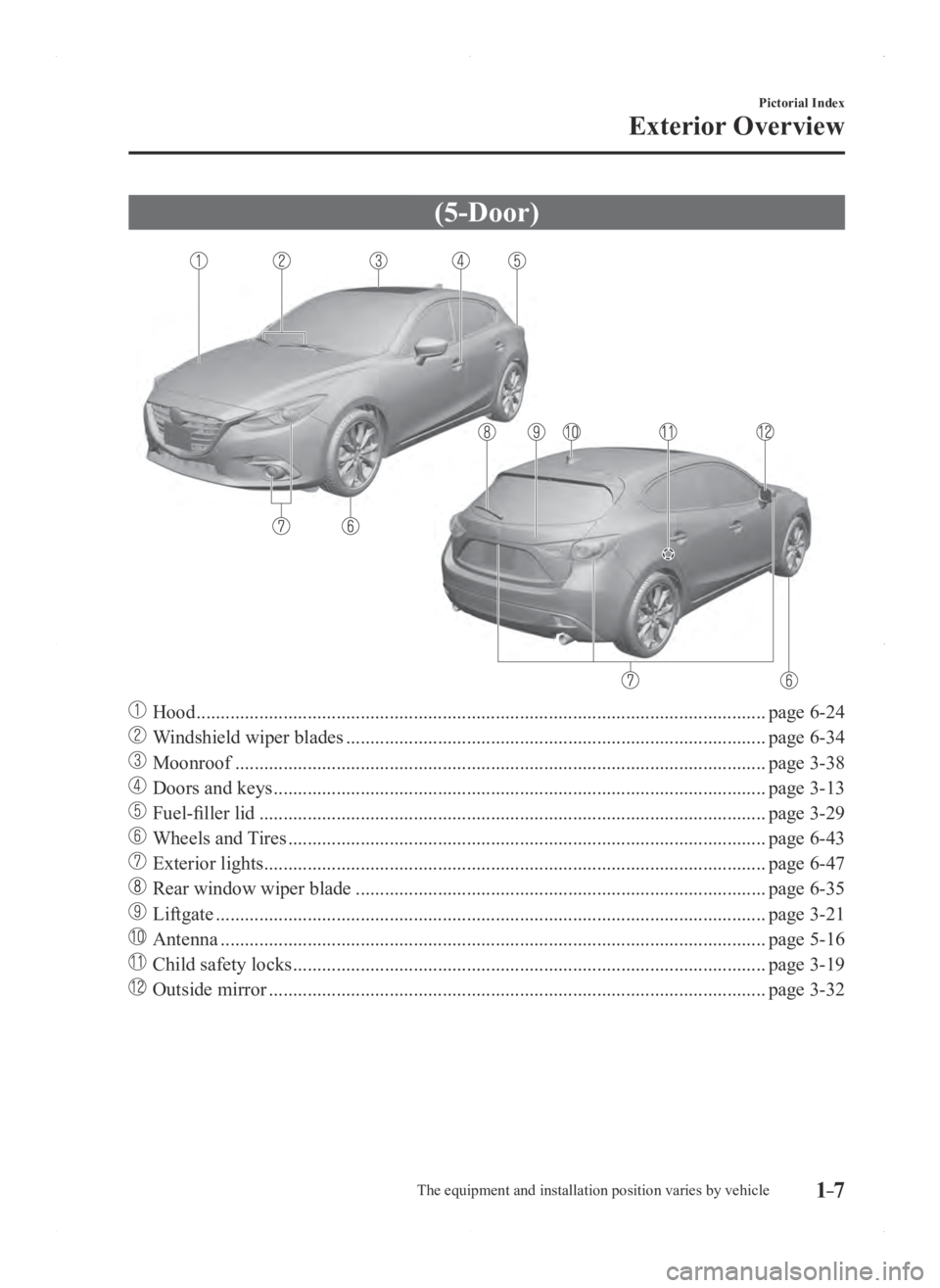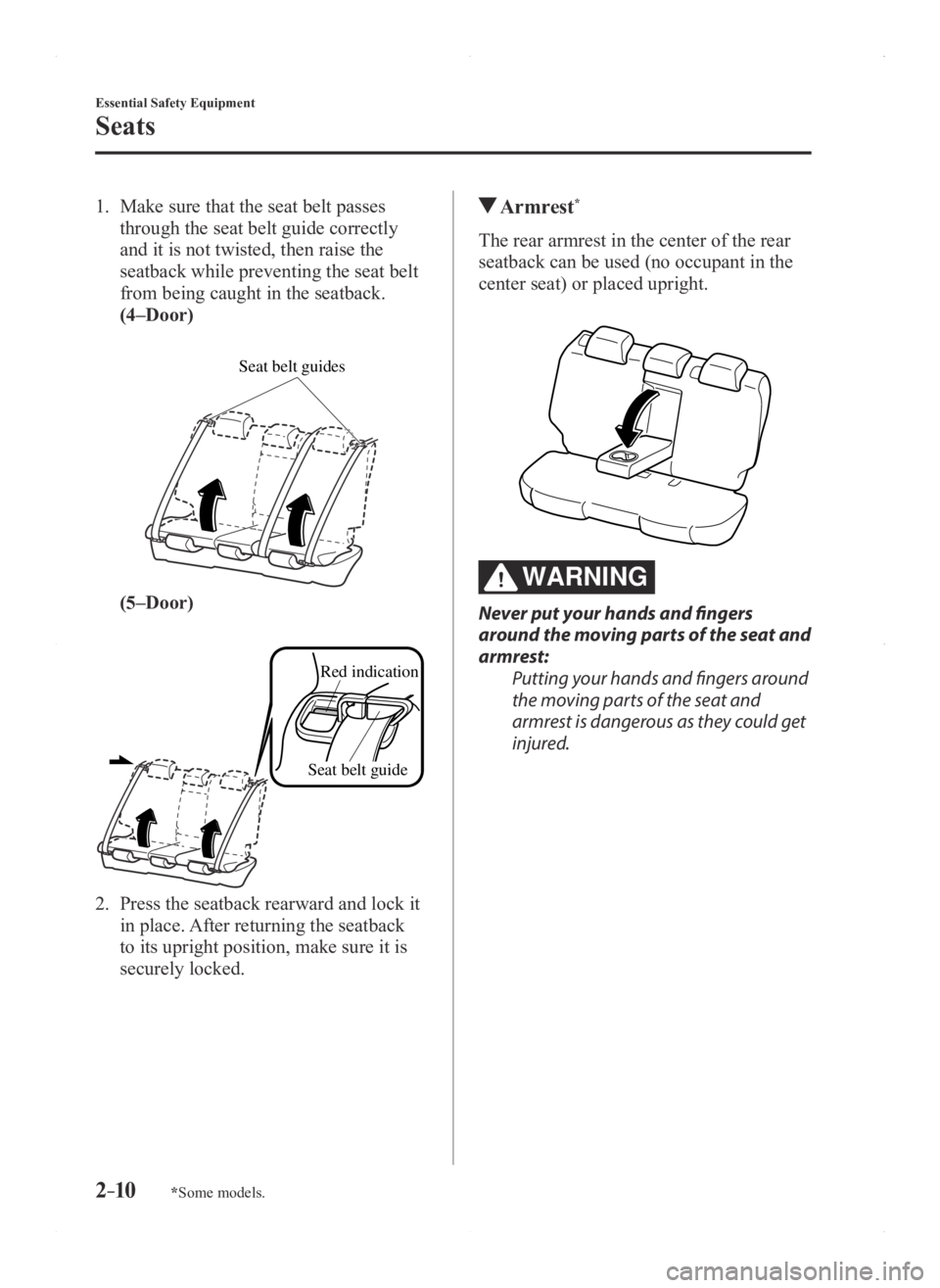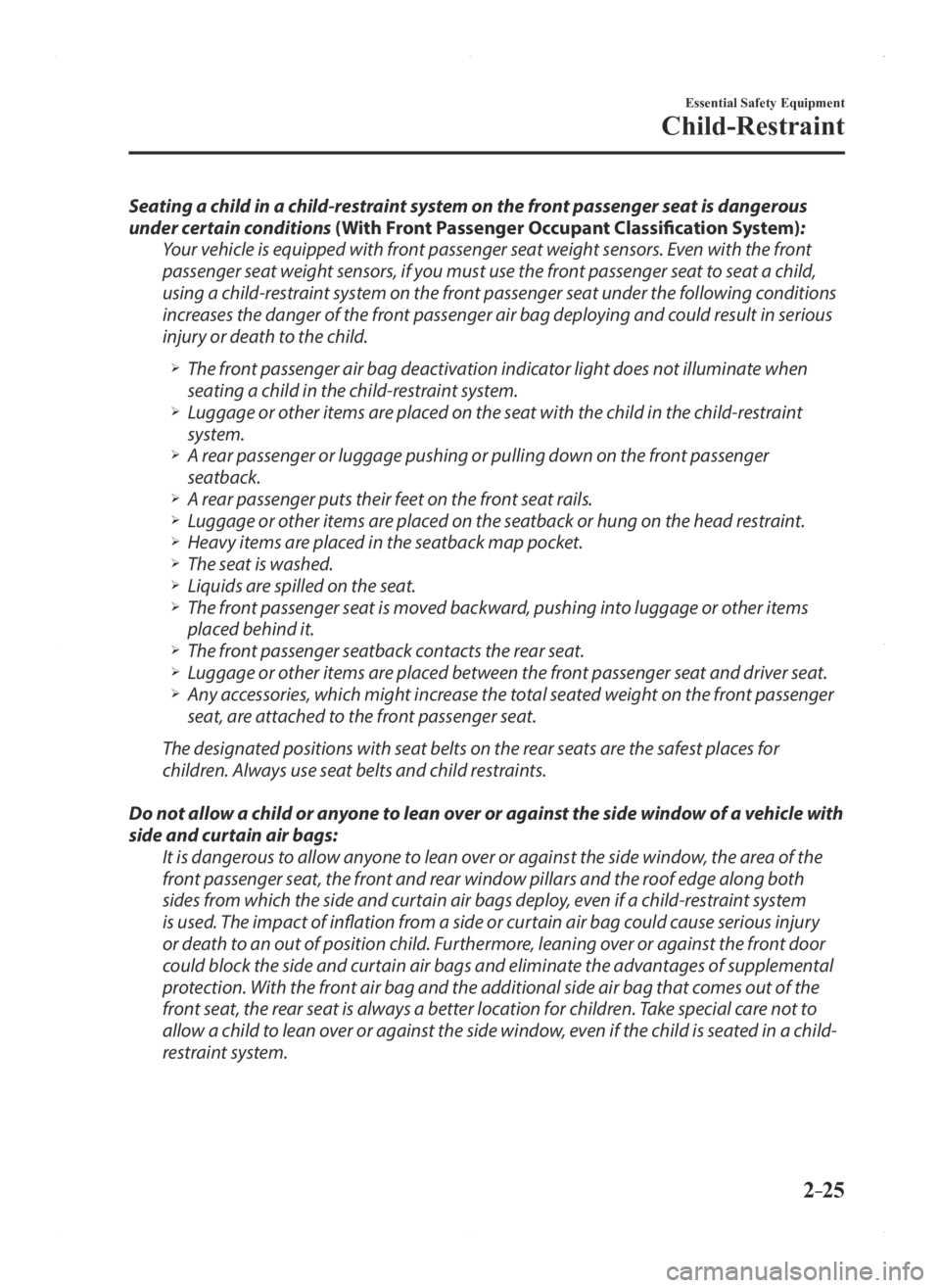door lock MAZDA MODEL 3 4-DOOR 2016 Owners Manual
[x] Cancel search | Manufacturer: MAZDA, Model Year: 2016, Model line: MODEL 3 4-DOOR, Model: MAZDA MODEL 3 4-DOOR 2016Pages: 598, PDF Size: 30.13 MB
Page 8 of 598

1–2
Pictorial Index
Interior Overview
Interior Equipment (View A)
Door-lock knob ........................................................................\
.............................page 3-18
Turn and lane-change signal ........................................................................\
.........page 4-46
Lighting control........................................................................\
.............................page 4-40
Wiper and washer lever ........................................................................\
.................page 4-47
DSC OFF switch ........................................................................\
...........................page 4-65
Tire pressure monitoring system set switch ........................................................page 4-126
LDWS switch ........................................................................\
................................page 4-83
AFS OFF switch........................................................................\
............................page 4-76
BSM OFF switch ........................................................................\
..........................page 4-91
Headlight leveling switch........................................................................\
..............page 4-44
Outside mirror switch........................................................................\
.................... page 3-32
Door-lock switch ........................................................................\
...........................page 3-16
Power window lock switch ........................................................................\
...........page 3-37
Power window switches ........................................................................\
................page 3-35
The equipment and installation position varies by vehicle
Mazda3_8FA4-EA-15G_Edition1.indb 22015/05/11 13:59:56
Page 12 of 598

1–6
Pictorial Index
Exterior Overview
(4-Door)
Hood ........................................................................\
..............................................page 6-24
Windshield wiper blades ........................................................................\
...............page 6-34
Moonroof ........................................................................\
......................................page 3-38
Doors and keys ........................................................................\
..............................page 3-13
Fuel-filler lid ........................................................................\
.................................page 3-29
Wheels and Tires ........................................................................\
...........................page 6-43
Exterior lights ........................................................................\
................................page 6-47
Trunk lid ........................................................................\
........................................page 3-21
Antenna ........................................................................\
.........................................page 5-16
Child safety locks ........................................................................\
..........................page 3-19
Outside mirror ........................................................................\
...............................page 3-32
The equipment and installation position varies by vehicle
Mazda3_8FA4-EA-15G_Edition1.indb 62015/05/11 13:59:59
Page 13 of 598

1–7
Pictorial Index
Exterior Overview
(5-Door)
Hood ........................................................................\
..............................................page 6-24
Windshield wiper blades ........................................................................\
...............page 6-34
Moonroof ........................................................................\
......................................page 3-38
Doors and keys ........................................................................\
..............................page 3-13
Fuel-filler lid ........................................................................\
.................................page 3-29
Wheels and Tires ........................................................................\
...........................page 6-43
Exterior lights ........................................................................\
................................page 6-47
Rear window wiper blade ........................................................................\
.............page 6-35
Liftgate ........................................................................\
..........................................page 3-21
Antenna ........................................................................\
.........................................page 5-16
Child safety locks ........................................................................\
..........................page 3-19
Outside mirror ........................................................................\
...............................page 3-32
The equipment and installation position varies by vehicle
Mazda3_8FA4-EA-15G_Edition1.indb 72015/05/11 13:59:59
Page 17 of 598

2–3
Essential Safety Equipment
Seats
Do not drive with either front seats reclined:Sitting in a reclined position while the vehicle is moving is dangerous because you do not
get the full protection from seat belts. During sudden braking or a collision, you can slide
under the lap belt and suffer serious internal injuries. For maximum protection, sit well
back and upright.
Do not place an object such as a cushion between the seatback and your back: Putting an object such as a cushion between the seatback and your back is dangerous
because you will be unable to maintain a safe driving posture and the seat belt cannot
function at its full capacity in a collision, which could result in a serious accident, injury or
death.
Do not place objects under the seat: The object could get stuck and cause the seat to not be fixed securely, and result in an
accident.
Do not stack cargo higher than the seatbacks: Stacking luggage or other cargo higher than the seatbacks is dangerous. During sudden
braking or a collision, objects can fly around and become projectiles that may hit and
injure passengers.
Make sure luggage and cargo is secured before driving: Not securing cargo while driving is dangerous as it could move or be crushed during
sudden braking or a collision and cause injury.
Never allow a passenger to sit or stand on the folded seatback while the vehicle is
moving: Driving with a passenger on the folded seatback is dangerous. Allowing a child to sit up
on the folded seatback while the vehicle is moving is particularly dangerous. In a sudden
stop or even a minor collision, a child not in a proper seat or child-restraint system and
seat belt could be thrown forward, back or even out of the vehicle resulting in serious
injuries or death. The child in the baggage area could be thrown into other occupants
and cause serious injury.
Never give the car keys to children and do not allow them to play in the vehicle (4–
Door): Playing with the folding rear seats is dangerous. Once the seatbacks are back up, a child
in the trunk would not be able to get out the way they had entered. If you have small
children, keep the seatbacks locked.
Mazda3_8FA4-EA-15G_Edition1.indb 32015/05/11 14:00:00
Page 18 of 598

2–4
Essential Safety Equipment
Seats
Always leave your car locked and keep the car keys safely away from children (4–
Door):Leaving your car unlocked or the keys in reach of children is dangerous. Children who find
their way into the trunk through an unlocked rear seatback or an open trunk can become
accidentally locked in the trunk. This could result in death or brain damage from heat
prostration, particularly in the summer. Always lock the doors and the trunk, and as an
added measure, keep the rear seatbacks locked, whether you have children in your home
or not.
CAUTION
When operating a seat, be careful not to put your hands or fingers near the moving parts of
the seat or on the side trim to prevent injury. When moving the seats, make sure there is no cargo in the surrounding area. If the cargo
gets caught it could damage the cargo. (Manual Seat)
When moving the seats forward and rearward or returning a rear-reclined seatback to its
upright position, make sure you hold onto the seatback with your hand while operating. If
the seatback is not held, the seat will move suddenly and could cause injury.
NOTE
When returning a rear seat to its original position, place the seat belt in its normal
position. Verify that the seat belt pulls out and retracts.
(Power Seat)
The seat-bottom power adjustment is operated by motors. Avoid extended operation
because excessive use can damage the motors.
To prevent the battery from running down, avoid using the power adjustment when the
engine is stopped. The adjuster uses a large amount of electrical power. Do not use the switch to make more than one adjustment at a time.
Mazda3_8FA4-EA-15G_Edition3.indb 42015/12/04 19:21:41
Page 23 of 598

2–9
Essential Safety Equipment
Seats
(4–Door)
1. (Split-folding type seat)
Open the trunk lid and pull the lever of
the seatback you want to fold down.
(One-piece folding type seat)
Open the trunk lid and pull the lever of
the seatback.
*1: With split-folding type seat only *1
2. Open a rear door and fold the rear seat
forward.
(5–Door)
Press the push knob to fold down the
seatback.
To return the seatback to its upright
position:
WARNING
When returning a seatback to its
upright position, make sure the 3-point
seat belt is not caught in the seatback
and the 3-point seat belt is not twisted. If the seat belt is used while it is twisted
and caught in the seatback, the seat
belt cannot function at its full capacity,
which could cause serious injury or
death.
When returning a seatback to its
upright position, make sure that it is
firmly locked and the red indication is
not visible (5–Door). If the red indication is visible behind
the push knob, it means the seatback
is not locked. If the vehicle is driven
without the seatback locked, it could
fold down suddenly and cause an
accident.
Locked position
Unlocked position Red indication
Mazda3_8FA4-EA-15G_Edition1.indb 92015/05/11 14:00:02
Page 24 of 598

2–10
Essential Safety Equipment
Seats
*Some models.
1. Make sure that the seat belt passes
through the seat belt guide correctly
and it is not twisted, then raise the
seatback while preventing the seat belt
from being caught in the seatback.
(4–Door)
Seat belt guides
(5–Door)
Red indication
Seat belt guide
2. Press the seatback rearward and lock it
in place. After returning the seatback
to its upright position, make sure it is
securely locked.
Armrest*
The rear armrest in the center of the rear
seatback can be used (no occupant in the
center seat) or placed upright.
WARNING
Never put your hands and fingers
around the moving parts of the seat and
armrest: Putting your hands and fingers around
the moving parts of the seat and
armrest is dangerous as they could get
injured.
Mazda3_8FA4-EA-15G_Edition1.indb 102015/05/11 14:00:02
Page 39 of 598

2–25
Essential Safety Equipment
Child-Restraint
Seating a child in a child-restraint system on the front passenger seat is dangerous
under certain conditions (With Front Passenger Occupant Classification System):Your vehicle is equipped with front passenger seat weight sensors. Even with the front
passenger seat weight sensors, if you must use the front passenger seat to seat a child,
using a child-restraint system on the front passenger seat under the following conditions
increases the danger of the front passenger air bag deploying and could result in serious
injury or death to the child.
The front passenger air bag deactivation indicator light does not illuminate when
seating a child in the child-restraint system. Luggage or other items are placed on the seat with the child in the child-restraint
system. A rear passenger or luggage pushing or pulling down on the front passenger
seatback. A rear passenger puts their feet on the front seat rails. Luggage or other items are placed on the seatback or hung on the head restraint. Heavy items are placed in the seatback map pocket. The seat is washed. Liquids are spilled on the seat. The front passenger seat is moved backward, pushing into luggage or other items
placed behind it. The front passenger seatback contacts the rear seat. Luggage or other items are placed between the front passenger seat and driver seat. Any accessories, which might increase the total seated weight on the front passenger
seat, are attached to the front passenger seat.
The designated positions with seat belts on the rear seats are the safest places for
children. Always use seat belts and child restraints.
Do not allow a child or anyone to lean over or against the side window of a vehicle with
side and curtain air bags: It is dangerous to allow anyone to lean over or against the side window, the area of the
front passenger seat, the front and rear window pillars and the roof edge along both
sides from which the side and curtain air bags deploy, even if a child-restraint system
is used. The impact of inflation from a side or curtain air bag could cause serious injury
or death to an out of position child. Furthermore, leaning over or against the front door
could block the side and curtain air bags and eliminate the advantages of supplemental
protection. With the front air bag and the additional side air bag that comes out of the
front seat, the rear seat is always a better location for children. Take special care not to
allow a child to lean over or against the side window, even if the child is seated in a child-
restraint system.
Mazda3_8FA4-EA-15G_Edition1.indb 252015/05/11 14:00:06
Page 44 of 598

2–30
Essential Safety Equipment
Child-Restraint
*Some models.
Tether strapForward
(5-Door)
Tether strap
Forward
Using Automatic Locking Mode*
Follow these instructions when using
a child-restraint system, unless you are
attaching a LATCH-equipped child-
restraint system to the rear LATCH lower
anchors. Refer to “Using LATCH Lower
Anchor” (page 2-36).
NOTE
Follow the child-restraint system
manufacturer's instructions carefully.
If you are not sure whether you have a
LATCH system or tether, check in the
child-restraint system manufacturer's
instructions and follow them accordingly.
Depending on the type of child-restraint
system, it may use LATCH system instead
of seat belts or if the belt goes across the
child's chest, may recommend against
using automatic locking mode.
1. Make sure the seatback is securely
latched by pushing it back until it is
fully locked.
2. Raise the head restraint to the top
locked position.
Refer to Head Restraints on page
2-11.
3. Secure the child-restraint system with
the lap portion of the lap/shoulder belt.
See the manufacturer's instructions
on the child-restraint system for belt
routing instructions.
4. To get the retractor into the automatic
locking mode, pull the shoulder belt
portion of the seat belt until the entire
length of the belt is out of the retractor.
Mazda3_8FA4-EA-15G_Edition1.indb 302015/05/11 14:00:08
Page 45 of 598

2–31
Essential Safety Equipment
Child-Restraint
5. Push the child-restraint system firmly
into the vehicle seat. Be sure the
belt retracts as snugly as possible. A
clicking noise from the retractor will be
heard during retraction if the system is
in the automatic locking mode. If the
belt does not lock the seat down tight,
repeat this step.
NOTE
Inspect this function before each use of
the child-restraint system. You should
not be able to pull the shoulder belt out
of the retractor while the system is in the
automatic locking mode. When you remove
the child-restraint system, be sure the
belt fully retracts to return the system to
emergency locking mode before occupants
use the seat belts.
6. If your child-restraint system requires
the use of a tether strap, refer to the
manufacturer's instructions to hook and
tighten the tether strap.
WARNING
Use the tether and tether anchor only
for a child-restraint system:Using the tether or tether anchor to
secure anything but a child-restraint
system is dangerous. This could
weaken or damage the tether or tether
anchor and result in injury.
Always route the tether strap between
the head restraint and the seatback: Routing the tether strap on top of
the head restraint is dangerous. In a
collision the tether strap could slide off
the head restraint and loosen the child-
restraint system. The child-restraint
system could move which may result in
death or injury to the child.
Anchor bracket
Tether strap(4-Door)
Anchor bracket
Tether strap
Mazda3_8FA4-EA-15G_Edition1.indb 312015/05/11 14:00:08